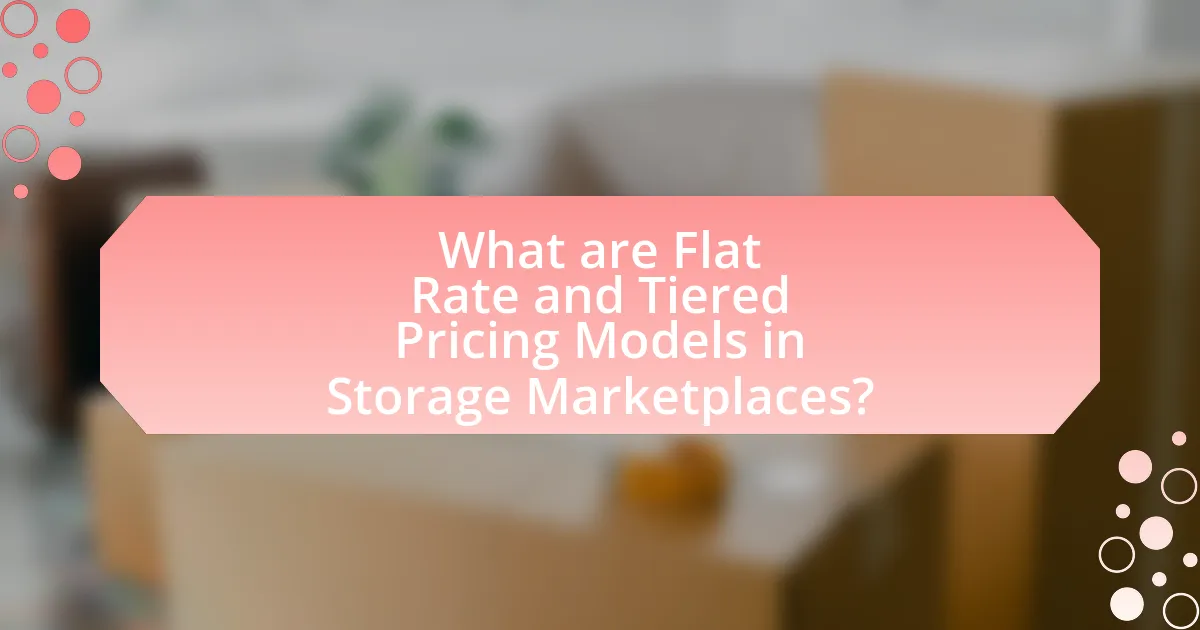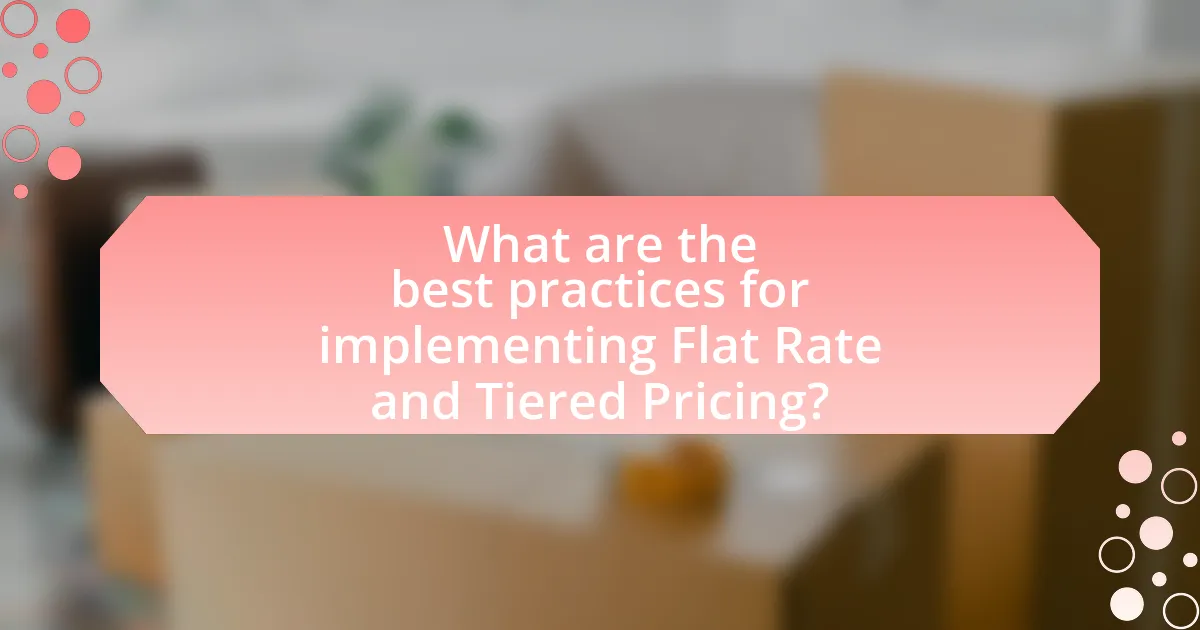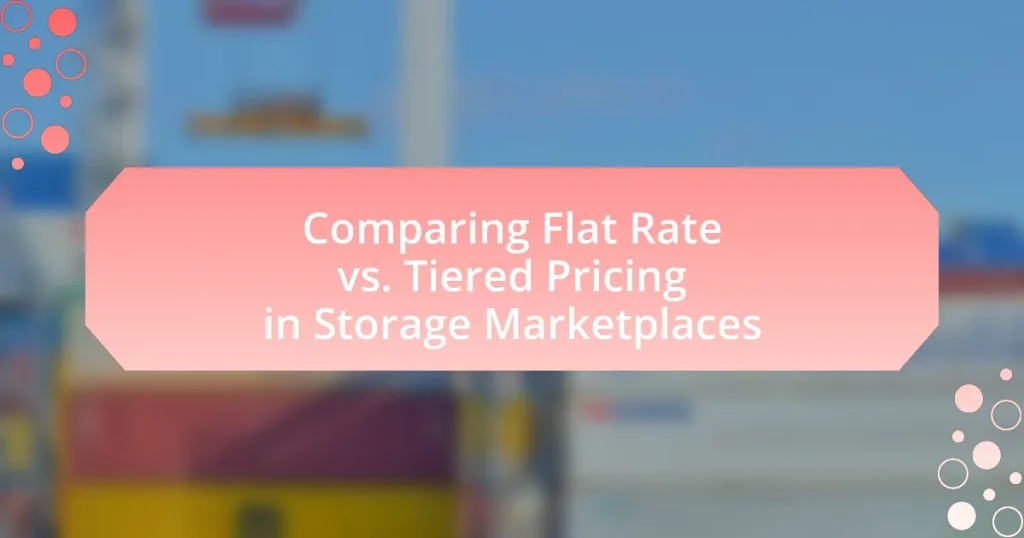The article focuses on comparing Flat Rate and Tiered Pricing models in storage marketplaces, highlighting their distinct characteristics and implications for consumers and businesses. Flat Rate pricing offers a single, fixed fee for storage services, providing predictability and simplicity for budgeting, while Tiered Pricing allows customers to pay based on their usage levels, incentivizing efficient storage management. Key advantages, consumer behaviors, and the financial impacts of each model are examined, along with best practices for implementation and strategies for optimizing customer retention. The article also discusses the factors influencing the effectiveness of these pricing structures and their implications for marketplace profitability.
What are Flat Rate and Tiered Pricing Models in Storage Marketplaces?

 |
|
Flat Rate and Tiered Pricing Models are two distinct pricing strategies used in storage marketplaces. Flat Rate pricing involves a single, fixed fee for a specific service or amount of storage, regardless of usage, making it straightforward for customers to understand their costs. In contrast, Tiered Pricing offers different pricing levels based on the amount of storage used or the features accessed, allowing customers to pay according to their specific needs and usage patterns. This model can incentivize users to optimize their storage consumption, as costs increase with higher usage tiers.
How do Flat Rate Pricing Models function in the storage marketplace?
Flat rate pricing models in the storage marketplace charge a fixed fee for a specified amount of storage, regardless of usage levels. This pricing structure simplifies budgeting for customers, as they know their costs upfront without worrying about variable fees based on consumption. For instance, a storage provider may offer a flat rate of $100 per month for up to 1TB of data storage, allowing users to store any amount of data within that limit without incurring additional charges. This model is particularly appealing to businesses with predictable storage needs, as it eliminates the uncertainty associated with tiered pricing, where costs can fluctuate based on usage.
What are the key characteristics of Flat Rate Pricing?
Flat Rate Pricing is characterized by a single, fixed fee charged for a service or product, regardless of usage levels. This pricing model simplifies budgeting for consumers, as they know the exact amount they will pay upfront. Additionally, Flat Rate Pricing often encourages higher consumption since users do not incur additional costs for increased usage. This model is commonly used in various industries, including telecommunications and utilities, where customers appreciate the predictability and transparency it offers.
What are the advantages of Flat Rate Pricing for consumers?
Flat Rate Pricing offers consumers predictability in their expenses, allowing them to know exactly what they will pay without unexpected charges. This pricing model simplifies budgeting, as consumers can plan their finances more effectively when they are aware of fixed costs. Additionally, Flat Rate Pricing often leads to perceived value, as consumers may feel they are receiving a better deal compared to variable pricing models that can fluctuate based on usage. Studies have shown that consumers prefer straightforward pricing structures, which can enhance customer satisfaction and loyalty.
How do Tiered Pricing Models operate in the storage marketplace?
Tiered pricing models in the storage marketplace operate by offering different pricing levels based on the amount of storage used. Customers pay a lower rate for initial tiers of storage and higher rates as their usage increases, incentivizing them to manage their storage needs efficiently. For example, a provider may charge $10 for the first 100 GB, $20 for the next 400 GB, and $50 for anything beyond 500 GB. This structure allows customers to scale their storage according to their requirements while benefiting from lower costs at lower usage levels. The tiered approach is effective in accommodating varying customer needs and optimizing revenue for storage providers.
What are the defining features of Tiered Pricing?
Tiered pricing is characterized by multiple price levels based on the quantity purchased or the level of service provided. This pricing model allows customers to benefit from lower rates as they buy in larger quantities or opt for higher service tiers. For instance, in storage marketplaces, tiered pricing can incentivize users to rent larger storage units or commit to longer rental periods by offering discounts at different thresholds, such as 10%, 15%, or 20% off based on the size or duration of the rental. This structure not only encourages bulk purchases but also enhances customer loyalty by providing perceived value through cost savings.
What benefits does Tiered Pricing provide to users?
Tiered pricing provides users with cost savings and flexibility based on their usage levels. This pricing model allows users to pay only for the storage they actually use, which can lead to lower overall costs compared to flat-rate pricing, where users pay a fixed amount regardless of their consumption. For instance, a user who requires minimal storage can benefit from lower rates at lower tiers, while those with higher storage needs can choose a tier that best fits their requirements, optimizing their expenses. Additionally, tiered pricing can incentivize users to manage their storage more efficiently, as they may seek to stay within a lower tier to minimize costs.
What are the main differences between Flat Rate and Tiered Pricing?
Flat Rate pricing charges a single fixed fee for a service regardless of usage, while Tiered Pricing offers different rates based on varying levels of consumption. In Flat Rate pricing, customers pay the same amount regardless of how much they use the service, which simplifies budgeting and can be more predictable. In contrast, Tiered Pricing incentivizes higher usage by providing lower rates for larger quantities consumed, allowing customers to potentially save money as their usage increases. This structure can lead to more complex billing but can also align costs more closely with actual usage, making it appealing for customers with fluctuating needs.
How do pricing structures impact consumer choice?
Pricing structures significantly influence consumer choice by affecting perceived value and affordability. For instance, flat rate pricing offers simplicity and predictability, making it easier for consumers to understand costs upfront, which can lead to higher conversion rates. In contrast, tiered pricing allows consumers to select options based on their specific needs and budget, potentially increasing satisfaction by providing perceived customization. Research indicates that 70% of consumers prefer transparent pricing models, which can enhance trust and loyalty. Therefore, the choice between flat rate and tiered pricing directly impacts consumer decision-making processes in storage marketplaces.
What factors influence the effectiveness of each pricing model?
The effectiveness of each pricing model in storage marketplaces is influenced by factors such as customer demand elasticity, market competition, and operational costs. Customer demand elasticity determines how sensitive consumers are to price changes; for instance, a flat rate may attract price-sensitive customers, while tiered pricing can maximize revenue from those willing to pay more for additional features. Market competition affects pricing strategies; in highly competitive environments, businesses may adopt tiered pricing to differentiate their offerings and appeal to various customer segments. Operational costs also play a crucial role; if costs are high, a flat rate might not cover expenses, whereas tiered pricing can help align pricing with service levels and usage patterns, ensuring profitability.
What are the implications of choosing Flat Rate vs. Tiered Pricing?
Choosing Flat Rate pricing simplifies billing and provides predictable costs for customers, while Tiered Pricing allows for flexibility and can cater to varying usage levels. Flat Rate pricing can lead to higher customer satisfaction due to its straightforward nature, but it may not maximize revenue for providers with diverse customer needs. In contrast, Tiered Pricing can optimize revenue by charging customers based on their actual usage, but it may introduce complexity that could confuse customers. Research indicates that businesses using Tiered Pricing can increase revenue by up to 20% compared to Flat Rate models, demonstrating the financial implications of each pricing strategy.
How does pricing model choice affect storage marketplace profitability?
The choice of pricing model significantly impacts storage marketplace profitability by influencing customer acquisition, retention, and revenue generation. Flat rate pricing typically attracts a broader customer base due to its simplicity and predictability, leading to higher initial sales volumes. In contrast, tiered pricing can optimize revenue from customers with varying storage needs, allowing marketplaces to capture more value from high-demand users while still appealing to budget-conscious customers. Research indicates that marketplaces employing tiered pricing can achieve up to 20% higher revenue per user compared to flat rate models, as they effectively segment the market and cater to diverse customer preferences.
What are the financial impacts of Flat Rate Pricing on businesses?
Flat Rate Pricing can significantly stabilize revenue streams for businesses by providing predictable income. This pricing model allows companies to charge a fixed fee for services, which simplifies budgeting and financial forecasting. According to a study by the Harvard Business Review, businesses that implement Flat Rate Pricing often experience increased customer retention, as clients appreciate the transparency and simplicity of costs. Additionally, this model can reduce administrative costs associated with billing and invoicing, leading to improved operational efficiency. Overall, Flat Rate Pricing can enhance financial predictability and customer satisfaction, positively impacting a business’s bottom line.
How does Tiered Pricing influence revenue generation?
Tiered pricing significantly influences revenue generation by allowing businesses to capture a broader range of customer willingness to pay. This pricing strategy enables companies to offer multiple price points for different levels of service or product features, thereby attracting both budget-conscious consumers and those willing to pay a premium for enhanced offerings. For instance, research indicates that businesses employing tiered pricing can increase their average revenue per user by as much as 20% compared to flat-rate pricing models, as it encourages upselling and cross-selling opportunities. This approach not only maximizes revenue from existing customers but also expands the customer base by appealing to diverse market segments.
What consumer behaviors are influenced by pricing models?
Pricing models significantly influence consumer behaviors such as purchasing decisions, perceived value, and brand loyalty. For instance, flat rate pricing often leads to increased purchase frequency as consumers appreciate the simplicity and predictability of costs, which can enhance their overall satisfaction. Conversely, tiered pricing can create a sense of urgency and encourage consumers to opt for higher tiers to maximize perceived value, as evidenced by research indicating that consumers are more likely to choose options that appear to offer better value for money. Additionally, pricing models can affect consumer trust; transparent pricing structures tend to foster greater trust and loyalty among consumers, as they feel more informed about their spending.
How do consumers perceive value in Flat Rate vs. Tiered Pricing?
Consumers perceive value in Flat Rate pricing as straightforward and predictable, while Tiered Pricing is viewed as flexible but potentially complex. Flat Rate pricing offers a single price for unlimited usage, which simplifies budgeting and reduces anxiety about unexpected costs. In contrast, Tiered Pricing provides different price levels based on usage, appealing to consumers who may want to pay less for lower usage but can lead to confusion regarding which tier to choose. Research indicates that 70% of consumers prefer Flat Rate pricing for its simplicity, while 30% appreciate the customization offered by Tiered Pricing, highlighting a clear preference for ease of understanding in value perception.
What are the common purchasing patterns associated with each model?
Flat rate pricing typically leads to predictable purchasing patterns, where customers prefer simplicity and transparency in costs, often resulting in higher customer retention. In contrast, tiered pricing encourages customers to purchase based on their specific needs, leading to varied purchasing behaviors as customers may opt for different tiers based on usage, which can result in increased revenue for providers as customers scale their storage needs. Research indicates that 70% of customers favor flat rate models for their straightforward nature, while tiered pricing can attract 60% of users looking for flexibility and cost efficiency.
What are the best practices for implementing Flat Rate and Tiered Pricing?

 |
|
The best practices for implementing Flat Rate and Tiered Pricing include clearly defining pricing structures, ensuring transparency for customers, and regularly analyzing market trends. Clear definitions help customers understand what they are paying for, while transparency builds trust and reduces confusion. Regular analysis of market trends allows businesses to adjust pricing strategies based on competitor pricing and customer demand, ensuring competitiveness and profitability. For instance, a study by the Harvard Business Review found that companies that regularly review their pricing strategies can increase revenue by up to 10%.
How can businesses effectively choose between Flat Rate and Tiered Pricing?
Businesses can effectively choose between Flat Rate and Tiered Pricing by analyzing their customer usage patterns and revenue goals. Flat Rate Pricing simplifies billing and appeals to customers who prefer predictability, making it suitable for businesses with a stable customer base and consistent usage. In contrast, Tiered Pricing accommodates varying customer needs and can maximize revenue by charging higher rates for increased usage, which is beneficial for businesses with diverse customer segments. Research indicates that companies employing Tiered Pricing can see a revenue increase of up to 20% compared to Flat Rate models, as it captures more value from high-usage customers.
What criteria should be considered when selecting a pricing model?
When selecting a pricing model, key criteria include customer demand, cost structure, competitive landscape, and revenue goals. Customer demand influences how much customers are willing to pay and their preferences for pricing structures. Cost structure determines the feasibility of maintaining profitability under different pricing models. The competitive landscape provides insights into what pricing strategies competitors are using, which can inform positioning. Revenue goals help define the financial targets that the pricing model should achieve, ensuring alignment with overall business objectives. These criteria collectively guide the decision-making process in choosing the most effective pricing model for storage marketplaces.
How can market research inform pricing strategy decisions?
Market research can inform pricing strategy decisions by providing insights into customer preferences, competitor pricing, and market demand. By analyzing data from surveys, focus groups, and sales trends, businesses can identify the optimal price points that align with consumer expectations and willingness to pay. For instance, a study by McKinsey & Company found that companies that leverage customer insights for pricing can achieve up to a 10% increase in revenue. This evidence underscores the importance of market research in shaping effective pricing strategies that resonate with target audiences.
What strategies can enhance the effectiveness of each pricing model?
To enhance the effectiveness of flat rate pricing, businesses can implement strategies such as simplifying the pricing structure to improve customer understanding and increasing perceived value through bundled services. For instance, offering additional features or services at no extra cost can attract more customers and encourage long-term commitments.
In the case of tiered pricing, strategies like clearly defining the benefits of each tier and using data analytics to optimize tier thresholds can significantly improve customer satisfaction and revenue. Research shows that customers are more likely to choose a tier that aligns with their needs when the differences between tiers are clearly communicated, leading to better conversion rates.
Both pricing models benefit from regular market analysis to adjust pricing strategies based on competitor actions and customer feedback, ensuring they remain competitive and relevant in the marketplace.
How can businesses optimize Flat Rate Pricing for customer retention?
Businesses can optimize Flat Rate Pricing for customer retention by ensuring that the pricing structure aligns with customer expectations and perceived value. This can be achieved by conducting regular market research to understand customer needs and preferences, which allows businesses to adjust their flat rate offerings accordingly. For instance, a study by McKinsey & Company found that companies that actively engage with customers to refine their pricing strategies can see a retention increase of up to 15%. Additionally, providing transparent communication about what the flat rate includes can enhance customer trust and satisfaction, further contributing to retention.
What techniques can improve Tiered Pricing appeal to consumers?
Techniques that can improve Tiered Pricing appeal to consumers include clear communication of value, strategic pricing tiers, and psychological pricing. Clear communication of value ensures that consumers understand the benefits associated with each tier, which can enhance perceived value. Strategic pricing tiers, designed to cater to different consumer segments, can attract a broader audience by addressing varying needs and budgets. Psychological pricing, such as setting prices just below a round number, can create a perception of a better deal, making the tiers more appealing. These techniques have been shown to increase consumer engagement and conversion rates in various pricing models.
What common pitfalls should businesses avoid in pricing strategy?
Businesses should avoid the common pitfalls of underpricing, overcomplicating pricing structures, and failing to consider customer perception in their pricing strategy. Underpricing can lead to reduced profit margins and may devalue the product or service, as evidenced by research showing that companies often struggle to raise prices after establishing a low price point. Overcomplicating pricing structures can confuse customers, leading to decision paralysis and lost sales; studies indicate that simpler pricing models often result in higher conversion rates. Additionally, neglecting customer perception can result in misalignment between pricing and perceived value, which can diminish customer trust and loyalty.
What mistakes can lead to ineffective pricing models?
Ineffective pricing models can result from several key mistakes, including a lack of market research, failure to understand customer segments, and neglecting competitor pricing strategies. For instance, without thorough market research, businesses may set prices that do not reflect customer willingness to pay, leading to lost revenue opportunities. Additionally, failing to segment customers can result in a one-size-fits-all pricing approach that alienates potential buyers who may be willing to pay more for tailored services. Lastly, ignoring competitor pricing can lead to misalignment in the market, causing a business to either overprice or underprice its offerings, which can diminish competitiveness and profitability.
How can businesses mitigate risks associated with pricing changes?
Businesses can mitigate risks associated with pricing changes by implementing a structured pricing strategy that includes market analysis, customer feedback, and competitive benchmarking. Conducting thorough market analysis allows businesses to understand demand elasticity and customer sensitivity to price changes, which can inform pricing decisions. Gathering customer feedback through surveys or focus groups helps identify potential reactions to pricing adjustments, enabling businesses to tailor their strategies accordingly. Additionally, competitive benchmarking ensures that pricing remains aligned with industry standards, reducing the risk of losing customers to competitors. These methods collectively provide a data-driven approach to pricing changes, minimizing potential negative impacts on revenue and customer retention.


